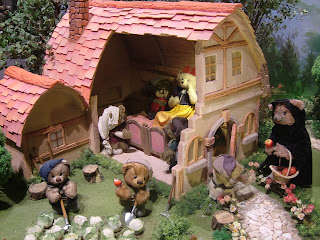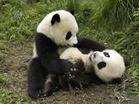It isn't pleasant reading an article like this on the first day of Chinese New Year. Yet, I think it's rather thought-provoking, whether from the viewpoint of an educator, a parent or simply an adult of a modern society. Before pointing fingers at who's to be responsible, these are the key questions that keep spinning in my mind: As an adult, do I have the courage to stand up to the teenage school bullies and defend the victim?As a teacher, how do I bring the victims AND the perpetraters out of their respective darkness?If we have never been bullied or a bully, can we really understand how those involved feel?What are the limits that an educator should abide to?Food for thought.. in the long run..=========================================================
By Daisaku IkedaDISTURBING incidents of bullying continue to make the news. We hear daily of the tragedy of children who, unable to endure the harassment and violence inflicted on them by peers and classmates, are driven to suicide.
It is heartbreaking to think of the pain and despair that would cause a child to take his or her life, and the consequent devastating grief suffered by their families.
Bullying is not a sickness unique to Japan. But the kinds of extreme bullying that can lead even to suicide have as their background the closed and insular nature of Japanese society. People of strong individuality, who have some quality that shines or stands out, are often the target of jealousy, and branded as different and strange.
As such, they may be subjected to an organised effort to ignore and ostracise them, leaving them feeling as if their very existence has been denied. Such isolation can be accompanied by threats, extortion and physical violence. Some children may become active supporters of the bullying while others, fearful that they will be targeted next, remain passive bystanders.
This dynamic reflects a deep-rooted pathology within Japanese society. It is rare for parents and teachers to muster the courage and solidarity to confront such bullying.
What would also appear to be unique to Japan is a particular quickness to blame the victim. There is a widely if unconsciously held notion that the victims of bullying are themselves at least partly responsible for their plight. This way of thinking acts to justify bullying as well as the indifference that allows it to continue.
How could anyone imagine there are people in the world who deserve to be bullied? Bullying is a base and vicious act that can never and must never be legitimated.
People are not bullied because they are weak. Rather, bullying reflects the inner weakness of the perpetrators, their inability to resist their own ugliest impulses. As Mahatma Gandhi pointed out, violence is ultimately born of cowardice.
The first step in dealing with bullying is to transform the cultural attitudes that permit it. This requires that we state clearly that the blame for bullying rests 100 per cent on those who bully.
This further requires that adults - whether parents or teachers - who become aware of bullying speak up, demonstrating a model of courage and action to children. Equally crucial is the effort to become the kind of person that a child being victimised by bullying can turn to with confidence. We need to be able to discern the often silent pleas of such children.
Bullying came to light as a serious social problem in Japan in the 1980s. The various forms of violence that had plagued schools in the 1970s had been brought under control but, it has been suggested, the forcefulness of the measures used to achieve this left the underlying issues unresolved, pushing violence underground and inward. The aggression once directed against teachers and the schools themselves was turned against classmates.
The rapid changes in society have left children exposed to intense forms of stress. The cold and unforgiving logic of the adult world is applied unmediated to the lives of children, who are subjected to excessive degrees of competition, selection, ranking and standardisation.
The dysfunction so evident in school bullying today thus mirrors the state of adult society, which is replete with insidious forms of bullying - detached cruelty stemming from cynicism and self-involvement, abuses of people's rights by the media, television programmes that poke fun at the vulnerable, prejudice and discrimination in their various forms. To surround children with such realities while expecting them to adhere to idealised forms of behaviour is hardly fair.
Urbanisation and the collapse of the extended family have deprived children of the physical and social spaces where they are affectionately enfolded and can comfortably develop friendships. And parents are often so pressed for time and stressed by work that they cannot fully engage or interact with their children.
Many children who become violent carry a deep-rooted sense of being neglected and ignored. The healthy growth of children requires that they feel accepted and embraced for who they are. When children can feel acceptance, they develop a natural awareness of their own unique and irreplaceable value. They then come to treasure and care for themselves. At the same time, this awakens feelings of trust and respect for others.
In the end, children desire but one thing - to be loved. This is why the family must be a haven of security and protection for children.
Rosa Parks once shared with me her mother's words: 'There is no law that people have to suffer.' Her mother also taught her the value of self-respect, to respect both herself and others. In these childhood lessons, I think, we can see the deep sources of courage and dignity behind her crucial role in the 1955 Montgomery bus boycott that marked a historic turning point in the American civil rights movement.
Every child has the right to move proudly into the future, head held high. The horror of a society permeated by different forms of bullying is that it tramples on children's sense of self-worth, robbing them of the light of future hope.
All young people need to be clearly assured that when we are suffering, although it may feel like the darkness will continue forever, that is absolutely not the case. Night always yields to dawn. Though the cold of winter may seem to last forever, it is always followed by spring. And those who have suffered most are best able to understand the feelings of other people. They have a unique and vital contribution to make.
Children are our only future, our sole, irreplaceable hope. Children are urging us - literally at the risk and cost of their lives - to become aware of the distortions of the adult world. Our response to their silent cries holds the key to healing the desperate illness of our times. Only by turning to directly engage with children, their feelings and their needs, will we redeem our own humanity.
The writer is president of Soka Gakkai International, and founder of Soka University and the Toda Institute for Global Peace and Policy Research.
















































































